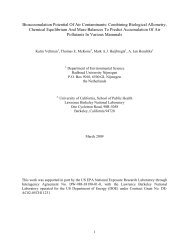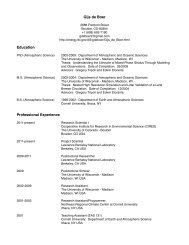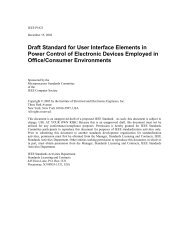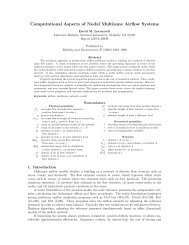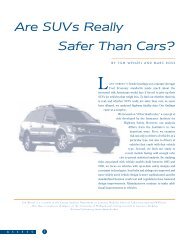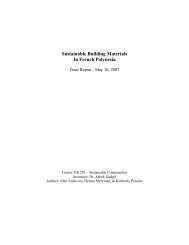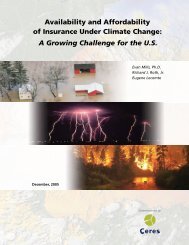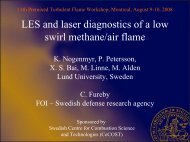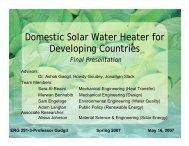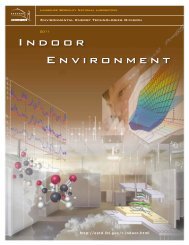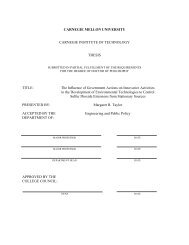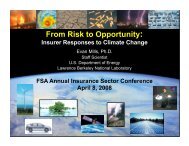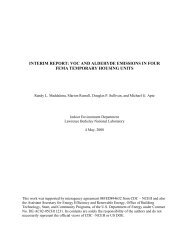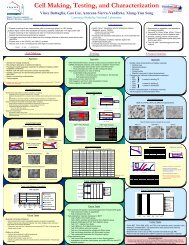indoor-outdoor air leakage of apartments and commercial buildings
indoor-outdoor air leakage of apartments and commercial buildings
indoor-outdoor air leakage of apartments and commercial buildings
Create successful ePaper yourself
Turn your PDF publications into a flip-book with our unique Google optimized e-Paper software.
7.2.2. Apartment Buildings Data Analysis<br />
Compiling, summarizing, <strong>and</strong> analyzing the available data on apartment leakiness was one <strong>of</strong><br />
the primary goals <strong>of</strong> this study, at the same level <strong>of</strong> importance as analyzing the <strong>commercial</strong><br />
<strong>buildings</strong> data. However, the extreme scarcity <strong>of</strong> apartment data <strong>and</strong> the complexities <strong>of</strong> the<br />
existing data make it impossible to go beyond the most basic data summaries <strong>and</strong> analyses.<br />
Therefore, the discussion <strong>of</strong> apartment data is substantially shorter <strong>and</strong> less detailed than the<br />
discussion <strong>of</strong> the <strong>commercial</strong> building data.<br />
Data were collected from 13 different studies on apartment <strong>buildings</strong> in the u.s. <strong>and</strong><br />
Canada (Wray 2000, Palmiter et al. 1995, Dietz et al. 1985, Lagus <strong>and</strong> King 1986, Love 1990, Hill<br />
2001, Gulay et a11993, DePani <strong>and</strong> Fazio 2001, Shaw et a11990, Reardon et al. 1987, Kelly et al.<br />
1992, Feustel <strong>and</strong> Diamond 1996, Diamond 1993, Fl<strong>and</strong>ers 1995). Most <strong>of</strong> the researchers<br />
attempted to<br />
Apartment <strong>buildings</strong> are, <strong>of</strong> course, composed <strong>of</strong> many individual <strong>apartments</strong> Or<br />
"suites" that are at least somewhat isolated from each other in terms <strong>of</strong> <strong>air</strong> exchange. For this<br />
reason, there are several separate issues related to ventilation in apartment <strong>buildings</strong>.<br />
1. There is <strong>leakage</strong> from individual <strong>apartments</strong> to (or from) the <strong>outdoor</strong>s. This is<br />
important from the st<strong>and</strong>point <strong>of</strong> energy efficiency, since undesired infiltration (or ex filtration)<br />
increases heating or cooling costs. It is also important for occupant comfort, since it affects<br />
drafts, the presence <strong>of</strong> moisture problems (which can lead to mold or mildew), <strong>indoor</strong><br />
temperatures, <strong>and</strong> the exposure <strong>of</strong> occupants to <strong>outdoor</strong> <strong>air</strong> pollution. This is the primary focus<br />
<strong>of</strong> the portion <strong>of</strong> the present work that deals with <strong>apartments</strong>.<br />
2. There is <strong>leakage</strong> from one apartment to another. This is important from the st<strong>and</strong>point<br />
<strong>of</strong> occupant satisfaction, since cooking <strong>and</strong> smoking odors from one apartment can bother<br />
occupants <strong>of</strong> an adjacent apartment. It is also important from the st<strong>and</strong>point <strong>of</strong> occupant health<br />
<strong>and</strong> safety, as occupants are exposed to environmental tobacco smoke <strong>and</strong> other pollutants from<br />
other <strong>apartments</strong>. This issue falls outside the scope <strong>of</strong> the present report, which focuses on<br />
<strong>indoor</strong>-<strong>outdoor</strong> <strong>leakage</strong>; however, it is clear to us from our literature review that this is a rather<br />
neglected area <strong>of</strong> research. Leakage between <strong>apartments</strong> (<strong>and</strong> from <strong>commercial</strong> establishments<br />
to <strong>apartments</strong>, in mixed-use <strong>buildings</strong>) may lead to large unintentional exposure <strong>of</strong> apartment<br />
dwellers to potentially hazardous or irritating substances such as tobacco smoke; dry cleaning<br />
chemicals or photographic chemicals; cooking gases, particles, or odors; <strong>and</strong> other pollutants.<br />
3. There is an interaction between the whole-building <strong>leakage</strong> <strong>and</strong> apartment-toapartment<br />
<strong>leakage</strong> (i.e. interaction between 1 <strong>and</strong> 2 above). If <strong>buildings</strong> are well<br />
compartmentalized (item 1) individual suites or floors can be separately ventilated, but if not,<br />
one suite can affect another (e.g. opening a window can change <strong>air</strong> flows into or out <strong>of</strong> every<br />
apartment on the floor or even throughout the building). This issue is outside the scope <strong>of</strong> the<br />
present report.<br />
Ten years ago, Diamond et al. (1996) conducted a literature review <strong>and</strong> analysis <strong>of</strong> all <strong>of</strong><br />
the apartment <strong>leakage</strong> data that were then available. They noted that "the literature on <strong>air</strong> flow<br />
<strong>and</strong> <strong>air</strong> <strong>leakage</strong> measurements in high-rise multifamily <strong>buildings</strong> is quite limited." They also<br />
said that "what emerges from a review <strong>of</strong> [the available] studies is the paucity <strong>of</strong> information<br />
characterizing <strong>air</strong> <strong>leakage</strong> in multifamily <strong>buildings</strong> <strong>and</strong> the typically poor level <strong>of</strong> control in the<br />
33



